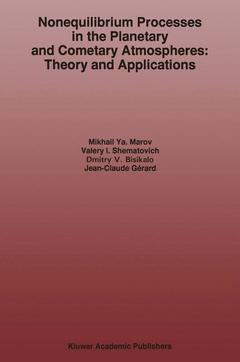Nonequilibrium Processes in the Planetary and Cometary Atmospheres: Theory and Applications, Softcover reprint of the original 1st ed. 1997 Astrophysics and Space Science Library Series, Vol. 217
Langue : Anglais
Auteurs : Marov Mikhail Ya., Shematovich V., Bisikalo D., Gérard Jean-Claude

This book reviews the approach to the kinetic simulation of nonequilib rium processes in the planetary atmospheres which the authors developed and dealt with since the 1970s. The results of this study, which are focused on the nonequilibrium collisional processes in the atmospheres of planets and comets, are thoroughly reviewed and discussed. Many specific problems of atmospheric modeling, involving numerical evaluation of aeronomic pro cesses, are addressed and compared with the available experimental data. The kinetic approach proved to be especially effective to model the in teraction of the incident shortwave solar radiation with the rarefied gas of planetary upper atmospheres. It involves various processes of photolysis, en ergetic electron impacts, and accompanying numerous chemical reactions, as well as processes occurring in the intermediate ("transition") zones of planetary and cometary gas envelopes. The underlying mathematical treat ment is based on the stochastic approach for the solution of the Boltzmann type equation and implies the development of the efficient algorithms for its computer simulation. Some results of this study were previously summa rized in the monograph issued in Russian (Marov et al. , 1990) and later in the review paper published in Space Science Reviews (Marov et al. , 1996). The basic principles of stochastic simulation were first developed in the field of rarefied gas dynamics and were successfully applied to the solution of some engineering problems of aerodynamics and heat transfer.
1 Introduction.- 2 Planetary and cometary atmospheres: an aeronomy approach.- 2.1 Planetary atmospheres: general characteristics.- 2.2 Planetary upper atmospheres and ionospheres.- 2.3 Cometary atmospheres.- 3 Rarefied gas of planetary and cometary atmospheres as a nonequilibrium physical and chemical system.- 3.1 Main physical-chemical processes in the upper atmospheres.- 3.2 Nonequilibrium features of a rarefied atmospheric gas.- 4 Methods of mathematical modeling of rarefied gases in planetary and cometary atmospheres.- 4.1 Atmospheric gas: microscopic kinetic approach.- 4.2 Regimes of rarefied gas flow in the upper atmosphere.- 4.3 Basic approaches to the kinetic simulation of gas flows in the transition regime.- 5 Kinetic approach to the modeling of collisional processes in a rarefied gas.- 5.1 Stochastic simulation of a nonequilibrium kinetic system.- 5.2 Structural stochastic model for kinetic relaxation systems.- 5.3 Stochastic modeling of rarefied gas flows.- 6 Numerical kinetic models for aeronomy applications.- 6.1 Kinetic models of atmospheric sources of nonthermal particles.- 6.2 General scheme of the numerical kinetic model for atmospheric gas flows.- 6.3 Some additional remarks on the numerical models.- 7 Production of nonthermal particles by electromagnetic and corpuscular solar radiation.- 7.1 Elementary processes of nonthermal particle formation induced by the solar EUV flux.- 7.2 Geophysical input parameters.- 7.3 Photoionization and kinetics of photoelectrons.- 7.4 Kinetic rates of photodissociation and electron impact dissociation.- 8 Nonequilibrium chemistry of odd nitrogen in the Earth’s thermosphere.- 8.1 ‘Classical’ photochemistry of odd nitrogen.- 8.2 Nonthermal photochemistry of odd nitrogen in the lower thermosphere.- 8.3 Observationalsignature of nonthermal nitrogen in the Earth’s atmosphere.- 9 Role of nonlinear processes in the formation of neutral planetary coronas.- 9.1 Physical and chemical mechanisms of the corona formation.- 9.2 Linearized models of planetary coronas.- 9.3 A nonlinear kinetic model of the hot oxygen geocorona.- 10 Nonthermal particles in the Jovian atmosphere.- 10.1 The Jovian upper atmosphere and its energetics.- 10.2 Sources of hot H in the Jovian aurora.- 10.3 Model description.- 10.4 Fast H atom distribution.- 10.5 Ly-? profile in the presence of hot hydrogen.- 11 Transition regions in cometary atmospheres.- 11.1 Chemical composition of the cometary nucleus and coma.- 11.2 Nonequilibrium processes in the inner coma.- 11.3 Hot H atoms in the inner coma.- Conclusions.- References.
Date de parution : 11-2001
Ouvrage de 304 p.
15.5x23.5 cm
Thèmes de Nonequilibrium Processes in the Planetary and Cometary... :
© 2024 LAVOISIER S.A.S.
